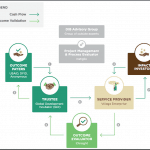Bringing the Tech Revolution to Health Care: New Report Provides First-Ever Snapshot of Global Digital Health Ecosystems
In 2017, in the aftermath of the Ebola epidemic, Sierra Leone launched its first National eHealth coordination hub, designed to coordinate and regulate digital health deployments throughout the country. The team at the Ministry of Health knew this hub was critical to building on its success in leveraging technology to address Ebola. It was viewed as essential to coordinate the country’s dispersed digital health efforts, but the team faced an immediate challenge: Where should they prioritize their efforts first in order to improve the country’s overall health ecosystem in a way that would improve the most lives?
That’s where the Global Digital Health Index (GDHI) – an interactive digital resource that tracks, monitors and evaluates the use of digital technology for health across countries – came in. Using the Index in coordination with the WHO’s Digital Health Atlas, Sierra Leone was able to determine that its digital health is in the “developing and building-up” phase. From there, it was able to lay out the 2018-2023 National Digital Health Strategy to address existing gaps.
As technology continues to play a bigger role in our health ecosystems, it is more critical than ever that we use a data-driven approach to measure and improve the status of our digital health structures at the national, regional and global level. Sierra Leone is not alone in using the GDHI as a tool to measure its progress in digital health; currently, 21 other countries actively participate in and use the Index. This data collected from the 22 participating countries is presented in our inaugural “State of Digital Health” report, released last week. In it, we provide the first-ever snapshot of digital health ecosystems throughout the world and lay the foundation for better informed and more coordinated investments.
The report includes countries from Africa, the Eastern Mediterranean, Europe, Latin America, Southeast Asia and the Western Pacific. Among those regions, it found that Southeast Asia, Europe and the Western Pacific have more mature digital health ecosystems, with Malaysia leading as the country with the most robust digital health ecosystem. Most of the countries are also doing well in the areas of digital health strategies and governance. For example, all but two participating countries have digital health included in their national health or relevant national strategies and plans, and most countries already have a functional digital health body in place.
However, major challenges remain, particularly in the areas of workforce, interoperability, privacy and cross-border data policies. These issues will require increased attention and investment in the coming years.
- Workforce: Currently, 91% of GDHI countries either provide no digital health training to health professionals as part of their pre-service training requirements, or only do so for less than 25% of health professionals. However, on the plus side we have also noted an increase in recent years in the number and range of digital health, health informatics, health information systems and biomedical informatics degree programs.
- Interoperability: Interoperability to enable the flow of data between information systems and technologies is a persistent challenge in most countries. GDHI found that almost half of the GDHI countries do not have national digital health architectural framework and/or health information exchanges. Collaborations, including the Health Data Collaborative’s Digital Health and Interoperability Working Group, are working to develop tools to support countries in the areas of interoperability and continuous improvement for health information systems.
- Policies: Protocols for regulating and certifying digital health devices and services, as well as cross-border data security and sharing, are lacking. Only 18% of the GDHI countries report having approved regulations for connected medical devices like glucometers for diabetes management and digital health apps and services, and only 32% of the GDHI countries have approved policies for cross- border data exchange and storage. This has become increasingly important in the past few years, with greater travel between countries in Europe – as well as with the recent upsurge in refugees from man-made and natural disasters. Such policies enhance the ability to facilitate continuity of care.
The State of Digital Health 2019 report lays the groundwork for building a comprehensive assessment of digital health worldwide. But further action is needed to continue to bring the digital health sector up to speed with the technology revolution. The GDHI is aiming to have 75+ countries participate by the end of 2019 in preparation for the State of Digital Health Report 2020. As more countries participate in the GDHI, the Index will more accurately represent the state of the field. And as the data around existing ecosystems improve, the field will mature, and more coordinated investments will be made.
We envision a world where countries are equipped with the data they need to make informed decisions on increasing the access and quality of health care, in order to improve the daily lives of their citizens. Ministries of Health looking to learn more about their digital health maturity, how it compares to other countries, and how they can improve it are encouraged to reach out to info@digitalhealthindex.org to participate in the Index.
Joanne Ke Edelman is a manager at the Global Development Incubator (GDI).
Photo courtesy of USAID Ethiopia.
- Categories
- Health Care, Technology



